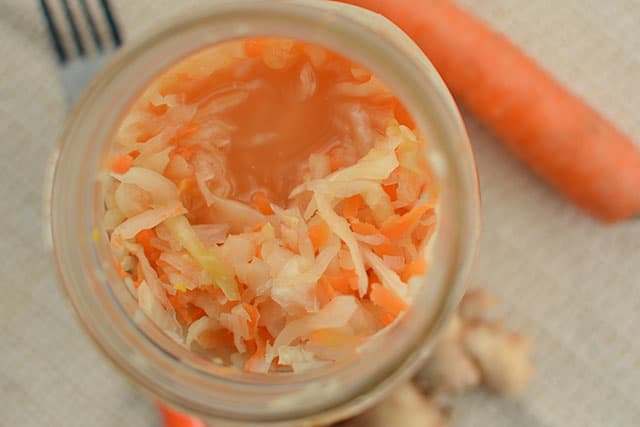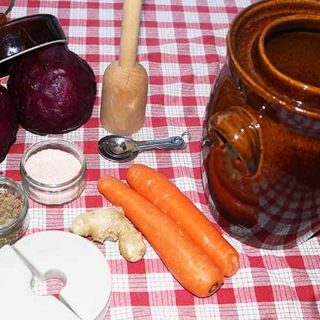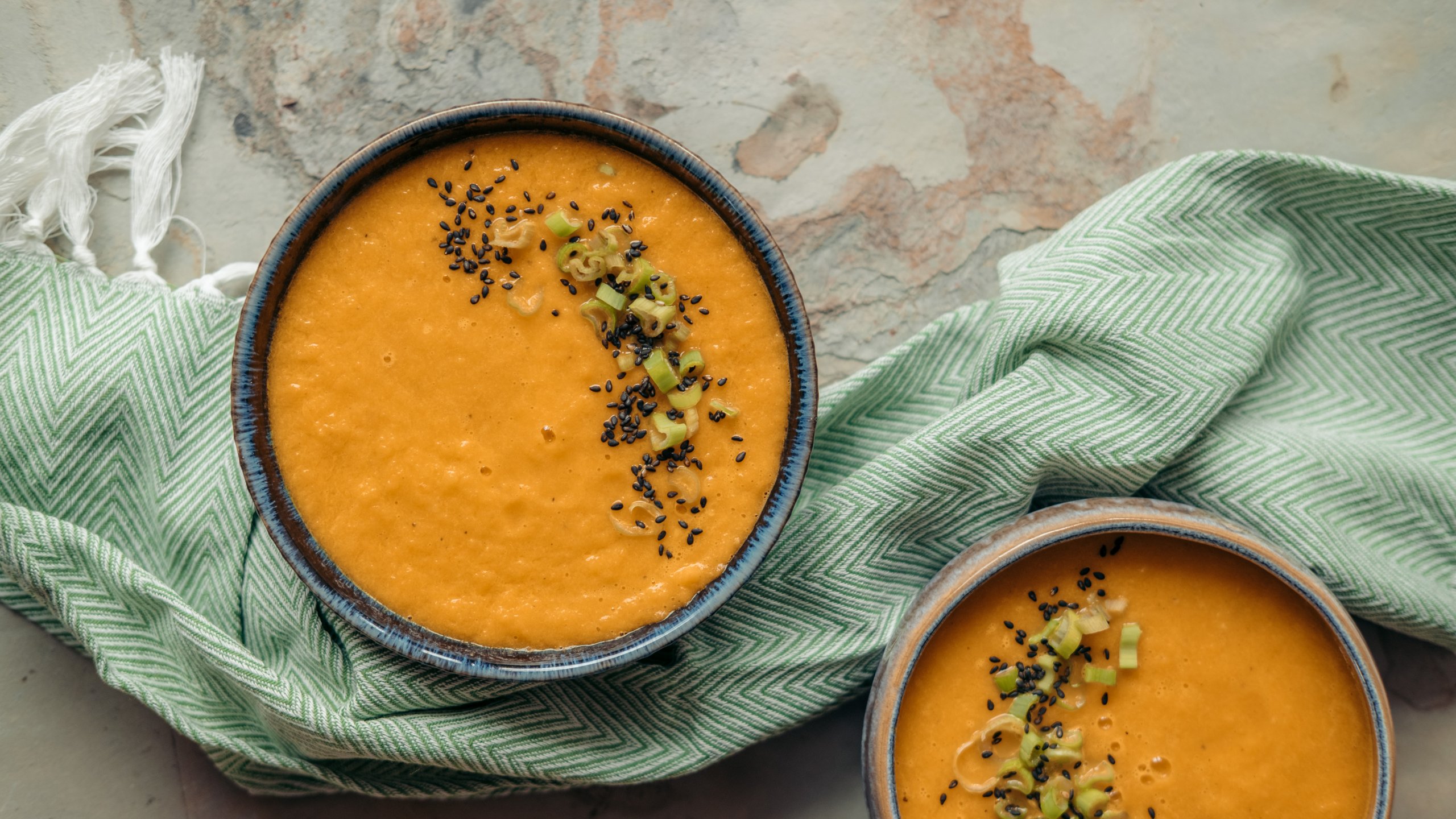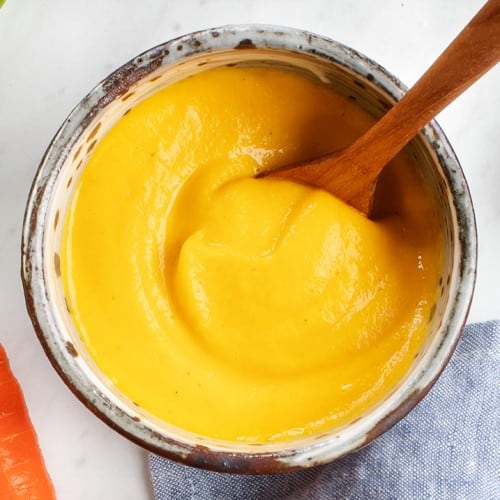Ginger Carrot Sauerkraut
3.9
(20)
Your folders
Your folders
Prep Time: 20 minutes
Servings: 28
Author : Holly Howe

Ingredients
Export 4 ingredients for grocery delivery
Instructions
Step 1
SET UP. Gather Supplies and Set Up ScaleUsing the right amount of salt makes for consistent, repeatable batches and establishes an environment for fermentation to unfold properly.You don’t want to include the weight of your bowl in your measurements, so either zero out the scale (usually done with a button on a digital scale or a knob under the tray on a mechanical scale) or write down the weight of your bowl (tare).
Step 2
CHOP. Prep Your Vegetables and CabbageWhen making sauerkraut, you first prepare the flavoring ingredients – carrots, ginger, garlic – then add sliced cabbage. This allows you to add only as much sliced cabbage as necessary to hit 1¾ pounds (28 ounces, 800 grams) on your scale.This is the amount that fits perfectly into a one-quart (liter) jar. Peel and grate carrots, grate or finely mince ginger, finely mince garlic and place in your bowl. Discard the limp outer leaves of the cabbage, setting aside one of the cleaner ones for use during the SUBMERGE step.Quarter, then slice cabbage crosswise into thin ribbons. I leave the core in because I find it helps to hold the layers of cabbage together making the slicing job easier.Add sliced cabbage to your bowl until weight of vegetables and cabbage is 1¾ pounds (28 ounces, 800 grams).
Step 3
SALT. Create Your BrineSalt is the workhorse in your ferment. It pulls water out of the cabbage to create an environment where the good bacteria can grow and proliferate and the bad bacteria die off. Just what we want!Sprinkle vegetables and cabbage with 1 tablespoon of salt and mix well. To create the brine without a lot of work, let the bowl of salted cabbage rest for 20 minutes to an hour. Then, massage the vegetables with strong hands until moist, creating the brine. You should be able to tilt the bowl to the side and see a good-sized puddle of brine, about 2–3 inches in diameter. This process can take anywhere from 2 to 5 minutes.
Step 4
PACK. Pack Mixture into JarNow that you have a puddle of brine, it’s time to pack the cabbage mixture into your jar.Grab handfuls of the salty, juicy cabbage mixture and pack them into your quart-sized wide-mouth canning jar, periodically pressing the mixture down tightly with your fist or a large spoon so that the brine rises above the top of the mixture and no air pockets remain.Be sure to leave at least 1 inch of space between the top of the cabbage and the top of the jar. Because we weighed out just the right amount of cabbage to fit in your jar, this should happen automatically.Pour any brine left in your mixing bowl into the jar and scrape out any loose bits stuck to the sides of the bowl or to the side of your jar.
Step 5
SUBMERGE. Hold Ferment Below BrineNow make sure your fermenting mixture is in a safe anaerobic (no air) environment. This means that you need to keep the cabbage mixture submerged in the brine while it ferments. Insert your Floaties Trap. Take that cabbage leaf you saved during the SETUP step, tear it down to just fit in the jar, and place it over the surface of the packed cabbage. Forgot to save a cabbage leaf? No problem. You can fold a narrow piece of parchment paper to size or even cut an old plastic lid to size. Place the 4-ounce jelly jar - or other item you're using as a weight - on top of the cabbage leaf, right side up with its lid removed. Lightly (to allow for escape of CO2 gases), screw on the white plastic storage lid.I like to label my jars using green or blue painter’s tape and a permanent marker. I note the flavor of sauerkraut I made and the date I started fermenting.
Step 6
FERMENT. Ferment for 1 to 4 WeeksTime now for the Mighty Microbes to work for you while you watch and wait. Can you wait 7 days to sample the tangy crunch? The jar on the left is on Day 1; the right, Day Notice how the colors have softened and the brine level has dropped. Place your jar of fermenting sauerkraut in a shallow bowl (to catch the brine that may leak out during the first week of fermentation), out of direct sunlight. Wait for 1 week before opening to sample.For what to expect as your sauerkraut ferments, see SALTY Cabbage to SOUR Sauerkraut: Fermentation Signs to MonitorShould the brine level fall (very unlikely) and remain below the level of the sauerkraut during this first week,dilute 1 Tbsp of salt in 2 cups of water and pour some of this brine over the sauerkraut (removing the little jar first) until it just covers the mixture. Put the little jar back in, screw the lid on lightly and let the fermentation continue.Don’t worry if the brine disappears after the 7- to 10-day mark. By this time, you’ve created a safe environment in which the bacteria that would cause mold or slime has been chased away by the beneficial bacteria produced during the fermentation process.You can ferment your sauerkraut for up to 4 weeks. The longer you ferment it, the greater the number and variety of beneficial bacteria that can be produced.
Step 7
STORE. Store in Refrigerator for Up to 1 YearAfter fermenting your sauerkraut, it’s ready to go into the refrigerator and ready to be tossed into a salad, spread on a hot dog and eaten straight from the jar!Rinse off the outside of the jar. You can take the little jar out. Clean the rim if necessary (sometimes it can get sticky from the brine that overflows), and screw the lid back on tightly.Add to your label how long you fermented the contents.Enjoy a forkful or two of your sauerkraut with your meals. It will continue to ferment – aging like a fine wine – but at a much slower rate that before. If the flavors are too intense, leave it the jar for a month or two and then eat it. You will be amazed at how the flavors have changed.If successfully fermented (tastes and smells good), your sauerkraut can be kept preserved in your refrigerator for up to a year.
Top similar recipes
Curated for youYour folders

 371 views
371 viewsCarrot, Ginger, and Red Cabbage Sau...
lowcarbalpha.com
5.0
(2)
Your folders

 229 views
229 viewsPolish Sauerkraut and Carrot Salad
allrecipes.com
4.8
(5)
Your folders

 473 views
473 viewsCarrot Ginger Soup
simplyrecipes.com
4.7
(178)
30 minutes
Your folders

 486 views
486 viewsGinger Carrot Soup
foodnetwork.com
4.7
(97)
45 minutes
Your folders

 519 views
519 viewsCarrot Ginger Dressing
justonecookbook.com
4.3
(157)
Your folders

 454 views
454 viewsCarrot & ginger soup
bbcgoodfood.com
30 minutes
Your folders

 250 views
250 viewsCarrot Ginger Soup
skinnytaste.com
4.8
(56)
40 minutes
Your folders
 87 views
87 viewsCarrot Ginger Soup
skinnytaste.com
Your folders

 183 views
183 viewsCarrot-Ginger Puree
myrecipes.com
4.0
(3)
Your folders

 282 views
282 viewsCarrot-Ginger Soup
thekitchn.com
5.0
(1)
45 minutes
Your folders

 461 views
461 viewsCarrot Ginger Dressing
healthyseasonalrecipes.com
5.0
(5)
Your folders

 352 views
352 viewsCarrot Ginger Dressing
cookieandkate.com
4.8
(93)
Your folders

 327 views
327 viewsCarrot Ginger Soup
leitesculinaria.com
5.0
(2)
Your folders

 186 views
186 viewsCarrot Ginger Muffins
delightfuladventures.com
5.0
(3)
20 minutes
Your folders

 223 views
223 viewsCarrot Ginger Soup
yuzubakes.com
5.0
(1)
Your folders

 208 views
208 viewsCarrot Ginger Soup
feelgoodfoodie.net
5.0
(48)
35 minutes
Your folders

 347 views
347 viewsCarrot Ginger Dressing
cookieandkate.com
4.8
(119)
Your folders

 312 views
312 viewsCarrot Ginger Dressing
loveandlemons.com
5.0
(5)
20 minutes
Your folders
 126 views
126 viewsGinger-Carrot Soup
foodnetwork.com
4.7
(34)
30 minutes